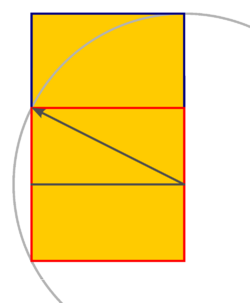Golden ratio: Difference between revisions
imported>Daniel Mietchen m (why does it follow - see talk) |
imported>Daniel Mietchen m (→Properties) |
||
| Line 15: | Line 15: | ||
:<math>\Phi = \frac{a}{b}= \frac{a+b}{a} = 1+\frac{b}{a} = 1+ \frac{1}{\Phi}</math>, | :<math>\Phi = \frac{a}{b}= \frac{a+b}{a} = 1+\frac{b}{a} = 1+ \frac{1}{\Phi}</math>, | ||
which leads to | which leads to | ||
:<math>\Phi^2-\Phi-1 = 0 </math>, | :<math>\Phi^2 - \Phi - 1 = 0 </math>, | ||
a [[quadratic equation]] wit the solutions | a [[quadratic equation]] wit the solutions | ||
Revision as of 01:17, 10 September 2009
The golden ratio is a mathematical proportion that is important in the arts and interesting to mathematicians. In architecture and painting, some works have been proportioned to approximate the golden ratio ever since antiquity. It has been claimed that the golden ratio is found in the proportions of architectural structures ranging from the Great Pyramid of Giza[1], to the Parthenon[2], to Chartres Cathedral[3]. In the 20th century, the golden section was applied by the French architect Le Corbusier[4], who used the proportion in the design of virtually all his architectural works, and in his his painting, and who wrote a series of books on the subject called The Modulor[5].
The ratio itself is also known as the mean and extreme ratio, the golden section, the golden mean, and the divine proportion. The earliest existing description is found in the Elements of Euclid (Book 5, definition 3): A straight line is said to have been cut in extreme and mean ratio when, as the whole line is to the greater segment, so is the greater to the less.
To be more elaborate: if there is a longer line segment and and a shorter line segment , and if the ratio between and is equal to the ratio between the line segment and , this ratio is the golden ratio .
Properties
Rewriting this definition gives
- ,
which leads to
- ,
a quadratic equation wit the solutions
- .
and
With we could derive the infinite continued fraction of the golden ratio:
Thus
- ,
where is the n-th term of the Fibonacci sequence.















